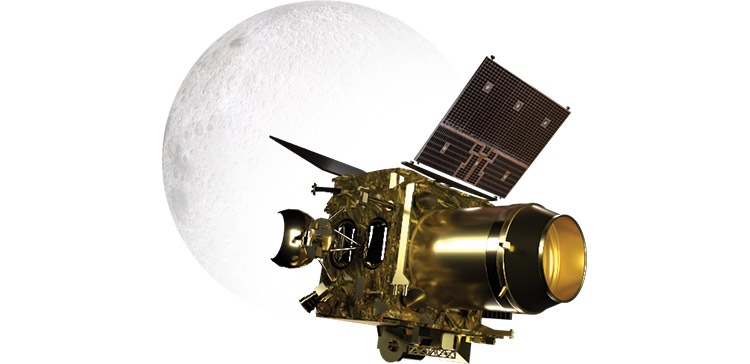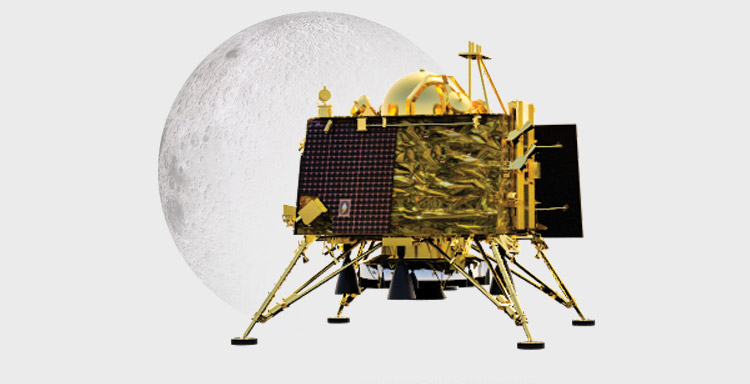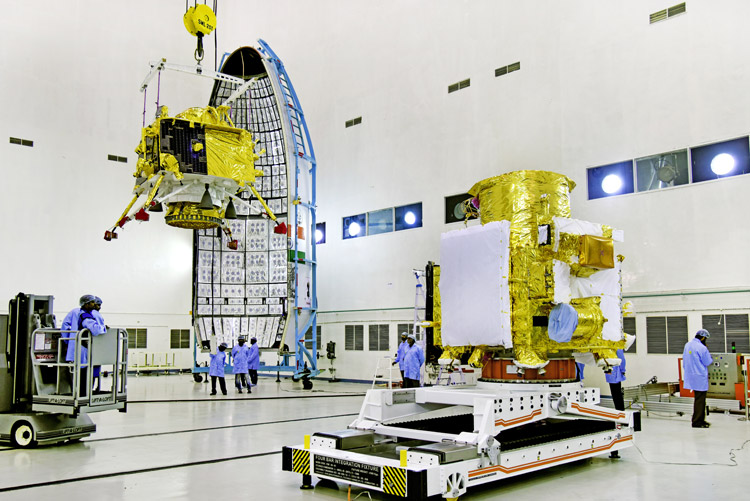- Prime Minister Narendra Modi inaugurates Aero India 2023 in Bengaluru; Releases Commemorative Stamp
- Defence Secretary meets delegations from Saudi Arabia, USA and Oman on the sidelines of Aero India 2023
- Foreign Ministers of 32 countries to attend Aero India 2023
- Embraer showcases the C-390 Millennium at Aero India 2023
Lander location traced, communication still remains uncertain
Over 24 hours after the mission control center in Bengaluru lost communication with the Chandrayaan-2 Lander, Vikram, its location was detected by the Orbiter revolving around the moon.
On Sunday, September 8, India's space agency found the location of Vikram Lander on the surface of the moon through the thermal image of Vikram that was captured by Chandrayaan-2's Orbiter. However, even as the lander's position has been spotted, there has not been any contact still with the lander to exactly know what happened or what may follow.
K. Sivan, chairman of the Indian Space Research Organisation (ISRO) informed the news agency, ANI, "We've found the location of VikramLander on lunar surface and orbiter has clicked a thermal image of the Lander. But there is no communication yet. We are trying to have contact. It will be communicated soon."
A thermal image is not like an image we click from a camera. It is the image that is deciphered by using radiations from the infrared region of the spectrum. This is to say that the Orbiter has not yet had direct communication with the lander and has neither seen it yet but it has captured the radiations that the lander is emitting.

The 2,379 kg Orbiter is revolving around the Moon at an altitude of 100km above the lunar surface in a polar orbit. The mission life of the Orbiter is one year and could communicate with the lander as well as on Earth. Carrying seven payloads, it is expected to collect crucial data for the mission.
The scientists at ISRO are still putting in all their efforts to re-establish communication with Vikram and hope to make some contact over the next 14 days, even when the chances look slim and very challenging. One lunar day that is one day on the moon is equal to 14 earth days, post which the lunar night would begin and it would get even more difficult to contact with the lander as the landing site would be under darkness.
Launched on July 22, from Sriharikota on the three-stage GSLV-Mk-III-M1 rocket, Chandrayaan-2 spacecraft consisted of three individual modules, an Orbiter, a Lander (named Vikram) and a Rover (named Pragyaan).
On September 2, at 1315 hrs IST, Vikram carrying Pragyaan had separated from the Orbiter of Chandrayaan-2.
The scientists at ISRO are still putting in all their efforts to re-establish communication with Vikram and hope to make some contact over the next 14 days, even when the chances look slim and very challenging. One lunar day that is one day on the moon is equal to 14 earth days, post which the lunar night would begin and it would get even more difficult to contact with the lander as the landing site would be under darkness.
The lander Vikram is also being reported to have had a hard landing. While there has been no official information on this yet but this could mean a damage to the lander or to some parts of it. It could also mean damage to the Rover Pragyaan or the losing the chances of any experiments that Pragyaan and Vikram would have performed over this one lunar day.
Vikram was scheduled for a soft landing on the lunar surface at about 1:55 am on Saturday, September 7.

When the 1471 kg lander was at an altitude of about 30km from the lunar surface, the power descent phase consisting of multiple phases including the rough breaking and the fine breaking phase was successfully initiated. Vikram was descending on to the lunar surface as planned and until 2.1 kilometers above the lunar surface, its performance was normal. However, the lander then lost signals to the ground station during this power descent, leaving everyone clueless among despair. Just in the next few minutes, Vikram was to have a soft landing on the moon. Vikram also carries inside it the 27 kg Rover, Pragyaan, which is a six-wheeled robotic vehicle. Pragyaan that leverages on solar energy was to traverse and inspect the lunar surface for a lunar day. It can only communicate with the Lander. Both Vikram and Pragyaan had to conduct a series of certain significant surface and sub-surface experiments.
The agency also highlighted that the Orbiter camera is the highest-resolution camera (0.3m) in any lunar mission so far and shall provide high-resolution images which will be immensely useful to the global scientific community. Not only that the Orbiter which was planned for a life-span of one year earlier, now instead ensures of a long life as long as almost seven years owing to the precise launch and mission management.
"The Vikram Lander followed the planned descent trajectory from its orbit of 35 km to just below 2 km above the surface. All the systems and sensors of the Lander functioned excellently until this point and proved many new technologies such as variable thrust propulsion technology used in the Lander," stated ISRO.
After the communication was lost, the scientists were devastated and the ISRO chief was left heartbroken. However, not only did the entire nation came forth to congratulate the scientists and show their support, even the global community was all praises for the space agency and its mission.
Space is hard. We commend @ISRO's attempt to land their #Chandrayaan2 mission on the Moon's South Pole. You have inspired us with your journey and look forward to future opportunities to explore our solar system together. https://t.co/pKzzo9FDLL
— NASA (@NASA) September 7, 2019
Acknowledging the complexity of the mission, ISRO too issued a statement on September 7."Chandrayaan-2 mission was a highly complex mission, which represented a significant technological leap compared to the previous missions of ISRO, which brought together an Orbiter, Lander, and Rover to explore the unexplored south pole of the Moon. Since the launch of Chandrayaan-2 on July 22, 2019, not only India but the whole world watched its progress from one phase to the next with great expectations and excitement," read the statement.
The agency also highlighted how this was a unique mission which aimed at studying not only one area of the Moon but all the areas including the exosphere, the surface as well as the sub-surface of the moon in a single mission.
While the Lander's and the Rover's situation are still not really know, the Orbiter which was successfully placed in its intended orbit continues to revolve around the Moon. "The Orbiter shall enrich our understanding of the moon's evolution and mapping of the minerals and water molecules in the Polar Regions, using its eight state-of-the-art scientific instruments, stated ISRO.

The agency also highlighted that the Orbiter camera is the highest resolution camera (0.3m) in any lunar mission so far and shall provide high-resolution images which will be immensely useful to the global scientific community. Not only that the Orbiter which was planned for a life-span of one year earlier, is now instead ensured of a long life as long as almost seven years owing to the precise launch and mission management.
ISRO also remarked that the success criteria were defined for each and every phase of the mission and till date 90 to 95% of the mission objectives have been accomplished and will continue to contribute to Lunar science, notwithstanding the loss of communication with the Lander.





